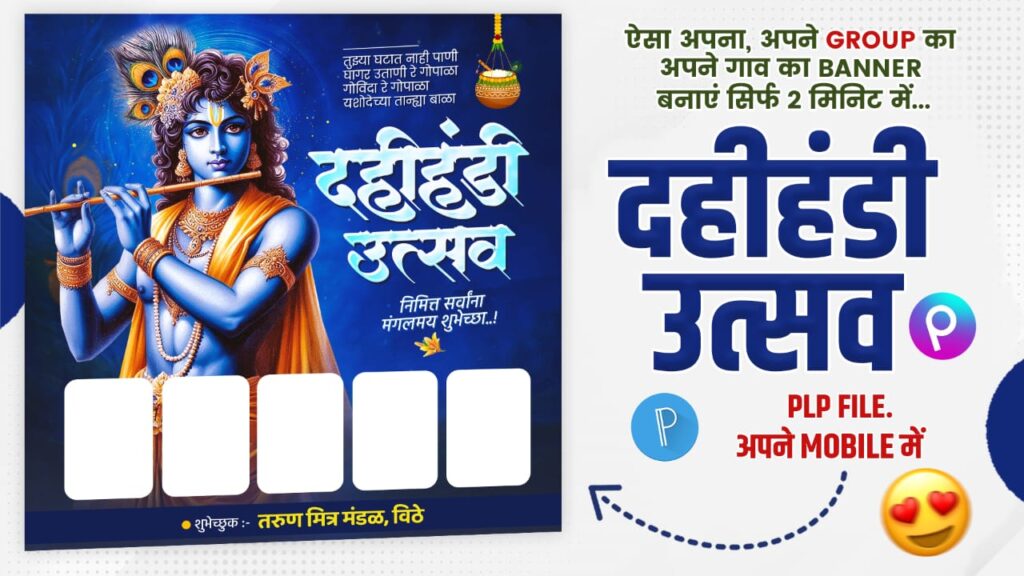🎉 Create Your Own Dahi Handi 2025 Banner in Just 2 Minutes!
History & Cultural Roots
Dahi Handi, an exuberant celebration deeply woven into the cultural fabric of India, especially Maharashtra, is more than just a festival—it’s a living expression of devotion, unity, and youthful energy. Its roots trace back to the legendary tales of Lord Krishna 🦚, the playful incarnation of Lord Vishnu, who was famously fond of butter and curd. As a mischievous child in Gokul, Krishna, along with his friends—the Gopalas—would form human pyramids to steal butter-filled pots hung high beyond their reach. This act, lovingly remembered and re-enacted every year, became symbolic of teamwork, courage, and joy. Over centuries, this simple act evolved into the grand event we know today as Dahi Handi 🥛. Celebrated primarily on Janmashtami—Krishna’s birthday—the tradition involves suspending a decorated earthen pot (handi) filled with curd, butter, fruits, and sweets high above the ground, challenging groups of young participants (Govindas) to form tall human pyramids to break it. This act is not only symbolic of Krishna’s childhood adventures but also represents the human spirit’s determination to reach great heights through cooperation and perseverance 💪. In ancient times, Dahi Handi also reflected agricultural abundance—milk and curd were symbols of prosperity, and sharing them among villagers fostered unity. Even the Marathi verses sung during the event carry wisdom, rhythm, and playful taunts that encourage the Govindas to push harder. The blend of devotion, myth, and local community spirit has made this festival a cherished tradition for generations.
The Celebration Across India 🇮🇳🎉
While Maharashtra is the beating heart of the Dahi Handi festival, its spirit has spread far and wide across India—adapting to local cultures yet preserving its core essence. In Mumbai and Thane, the atmosphere on Janmashtami is electrifying ⚡—streets are filled with colourful decorations, vibrant processions, and the beats of traditional drums (dhol-tasha) echoing through every lane. Young men and women, dressed in matching team T-shirts, chant “Govinda Ala Re!” 🎶 as they march towards the handi site. Competitions are fierce, with prize money reaching into lakhs, attracting professional Govinda Pathaks (teams) who train for months. In Pune, the celebration blends modern music with cultural performances, while in Nashik and rural Maharashtra, it retains a more traditional village charm. Beyond Maharashtra, cities like Indore, Jaipur, and even Delhi have embraced Dahi Handi, infusing it with their own flavours—Rajasthani folk music, Punjabi dhol beats, and sometimes even Bollywood-style stage performances. In Gujarat, the celebrations often merge with Janmashtami temple events, while in southern states, though less common, Krishna’s playful butter-stealing episodes are celebrated through dance and theatre. The festival has even crossed international borders 🌍, with Indian communities in the US, UK, and Australia hosting Dahi Handi events to stay connected with their roots. The energy, unity, and cheer it generates make it not just a religious observance but a social carnival that brings together people from all walks of life—rich and poor, urban and rural, young and old—under the same joyous banner.

——————————–••••••——————————-
Modern Trends, Records & Social Impact 💪✨
In recent decades, Dahi Handi has transformed into a massive, organised sporting event—complete with sponsors, media coverage 📺, and even celebrity appearances. Many Govinda teams now have corporate backers, custom uniforms, physiotherapists, and structured training programs. Heights of over 40 feet have been achieved, with human pyramids involving up to 9 tiers, setting records in the Limca Book of Records and even Guinness World Records 🏆. However, with the competitive spirit comes the responsibility of safety—authorities now enforce rules like mandatory helmets, safety nets, and age restrictions for participants. Despite this, the thrill of the climb, the tension in the crowd, and the final shattering of the handi still send waves of excitement through everyone present 🎇. Beyond the thrill, Dahi Handi carries deep social value—it fosters teamwork, teaches trust and communication, and breaks social barriers as people from different backgrounds join hands (and shoulders) to achieve a common goal. Many organisers now use the festival as a platform to spread social messages—road safety 🚦, environmental awareness 🌱, women empowerment, and anti-drug campaigns. Some events even donate their prize money to charitable causes, turning celebration into service. Social media 📱 has given Dahi Handi a global stage—viral videos of daring climbs, spectacular falls, and victorious moments attract millions of views, inspiring even more participation each year. What makes it truly special is that, even in this age of technology, it remains a festival that requires nothing more than human strength, courage, and unity—a timeless reminder that
together, we can reach any height 🪢🏅.
The Human Pyramid: Symbolism & Skill 🪢💥
The human pyramid in Dahi Handi is far more than a physical stunt—it’s a living symbol of unity, trust, and shared effort. Each level of the pyramid represents a foundation of faith—those at the base endure the most weight and pressure, often standing barefoot on the scorching road, holding the entire structure steady. Their strength and stability give confidence to the middle tiers, while the agile and fearless Govinda at the top—usually a young boy or girl—climbs with speed and precision to reach the handi 🎯. This hierarchy mirrors life itself: without a strong base of support, no goal can be reached. The coordination is breathtaking—team members communicate through short shouts and hand signals amid deafening drumbeats 🥁. Every layer requires perfect balance; even a slight misstep can bring the entire structure crashing down. In Maharashtra’s coastal towns, you’ll find an even riskier version—pyramids built on slippery, water-soaked streets, adding to the challenge. Watching the human pyramid rise is like witnessing a slow-motion miracle—an entire community holding its breath, hearts pounding, until the handi is struck and curd splashes over the crowd, symbolising victory and blessings 💦🙏.
Women in Dahi Handi 👩🦱💪
Traditionally, Dahi Handi was dominated by male teams, but in recent years, women’s participation has been breaking barriers and making headlines. Many all-women Govinda Pathaks have emerged across Mumbai, Pune, and Nashik, challenging stereotypes and proving that courage has no gender. Women climbers bring their own strengths to the game—remarkable agility, balance, and sharp coordination. Events now often have a separate women’s handi 🏆, with heights ranging from 15 to 25 feet, and the enthusiasm is infectious. In some cities, mixed teams—with both men and women—compete, symbolising equality and shared achievement. Women Govindas often train in gyms, practice yoga 🧘♀️ for balance, and engage in rigorous rehearsals just like their male counterparts. Their success has inspired many young girls to dream of joining a pyramid someday. This change is not just about sports—it’s about visibility, empowerment, and rewriting the cultural script. Crowds cheer just as loudly, if not louder, when a women’s team smashes the handi, making it clear that the future of Dahi Handi will be inclusive and diverse 🌟.
👇TODAYS DESIGN👇


Economic & Social Dimensions 💰🤝
Dahi Handi is not only a cultural festival—it’s an economic engine for many local communities. Thousands of people earn during this season—drummers, decorators, sound engineers, stage builders, lighting crews, costume makers, food vendors, and transport workers all find business booming. Sponsorships from brands—ranging from soft drinks 🥤 to sportswear companies—inject large sums into the event, often leading to prize money in the lakhs. This financial involvement has professionalised the sport, encouraging teams to register formally, maintain fitness year-round, and invest in safety gear. On a social level, Dahi Handi is a platform where barriers of caste, religion, and status dissolve—rich and poor stand shoulder-to-shoulder, united by a common goal. Politicians also see it as an opportunity to connect with the masses, leading to even grander celebrations. In many villages, it’s the biggest event of the year, with the local economy revolving around preparations for weeks. This fusion of tradition and commerce has ensured that Dahi Handi remains vibrant, relevant, and financially sustainable for generations.
——————————–••••••——————————-
The Emotional Core of Dahi Handi ❤️🎶
At its heart, Dahi Handi is about emotion—the surge of devotion when the first drumbeat sounds, the tension as the pyramid rises, the gasp when someone slips, the roar of relief when they’re caught safely, and the explosion of joy when the handi finally shatters 🥳. For many, it’s also a spiritual experience—being part of the pyramid is an offering of one’s strength and courage to Lord Krishna. Spectators often describe goosebumps when they witness the top climber bow to the handi before striking it, as if saluting both the divine and the human effort that made the climb possible 🙏. Songs dedicated to Krishna—both traditional abhangs and modern Bollywood hits—fill the air, making the atmosphere almost magical. And when the curd and water pour down, drenching the pyramid, it feels like blessings are flowing over the entire community. The festival leaves behind memories that last a lifetime—of unity, risk, thrill, and joy. It’s no wonder that even in a rapidly changing India, Dahi Handi continues to capture hearts year after year.
🧑🤝🧑🌍 TELEGRAM 🧑🤝🧑🌍

⛔ So guys, you will get all the editing apps, our updates, and banner materials like PLP, PNG, PSD, and much more on our Telegram channel. So make sure to join it! ⛔
——————————–••••••——————————-
🔴 HD QUALITY MATERIAL 🔴
📌 HD PLP File 📌
📌 HD PNG File 📌
•••••••••••••••••••••••••••••••••••••••••
👇 OUR NEXT POST 👇
How to Make Guru Purnima Banner on Mobile – Free PLP & PNG Download
